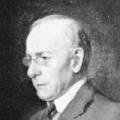
Louis Sullivan (1856 – 1924)
Louis Sullivan is widely considered America’s first truly modern architect. Instead of imitating historic styles, he created original forms and details. Older architectural styles were designed for buildings that were wide, but Sullivan was able to create aesthetic unity in buildings that were tall.
Sullivan’s designs generally involved a simple geometric form decorated with ornamentation based on organic symbolism. As an organizer and formal theorist on aesthetics, he propounded an architecture that exhibited the spirit of the time and needs of the people. Considered one of the most influential forces in the Chicago School, his philosophy that form should always follow function went beyond functional and structural expressions.
Sullivan’s designs often used masonry walls with terra cotta designs. Intertwining vines and leaves combined with crisp geometric shapes. This Sullivanesque style was imitated by other architects, and his later work formed the foundation for the ideas of his student, Frank Lloyd Wright.
Louis Sullivan believed that the exterior of an office building should reflect its interior structure and its interior functions. Ornament, where it was used, must be derived from Nature, instead of from classical architecture of the past. The work of Louis Sullivan is often associated with the Art Nouveau movement in architecture.
Notable Buildings:
1890 – Wainwright Building
1907 – National Farmers’Bank (Sullivan’s “Arch”)
1907 – Babson House, Riverside, Illinois.
1910 – The Bradley House
1910 – St. Paul’s Church, Cedar Rapids, Iowa.